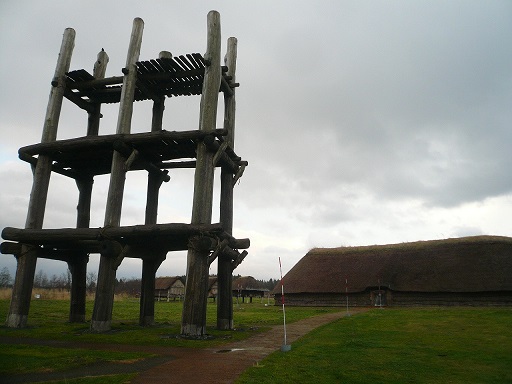A couple of different type of houses existed. Some houses were thatched with reed, "Kaya" and others were covered with soil or grass as well.
In the middle of Sannai-Maruyama Archaeological Site, the huge wooden tower building was rebuilt.
Six postholes in two rows were excavated out with 4,2 meters intervals.
Experts do not understand how the building structure was and for what purpose the building was.
However, it was sure that people in the Jyomon Age had high skill of surveying techniques and settled in this place.
These were the previous established theories that people in the Jyomon Age did hunting for a living and moved following their food, like nuts, fruits and animals without cultivation.
However, the results of Sannai-Maruyama Archaeological Site excavation inverted the previous established theories. In addition to high skill of surveying techniques, it was also confirmed that people in the Jyomon Age cultivated Japanese chestnut here in Sannai-Maruyama Archaeological Site.
Near to the huge wooden tower building, a huge house was also rebuilt.
The house has 250 square meters of floor area and this is the biggest pit-house in Japan.
It was built 4,300 years ago. The house was wide and it seems that twenty to thirty people could live together in the house.
The pillars' intervals of the house were multiples of 70 centi-meters.
The same intervals were confirmed not only at Sannai-Maruyama Archaeological Site, but also other archaeological sites in the Tohoku area. It is considered that 70 centi-meters were the common length unit in the Jyomon Age.
Next to Sannai-Maruyama Archaeological Site, the historical museum, "Jyomon Jikuukan", was open in 2002 to display discovered earthenware, stoneware and earthen figures.
Couple of 10,000s of evacuated articles were discovered and 1,958 discoveries are designated as important properties of Japan.
The above picture shows a discovered earthen figure. Such earthen figures are often excavated at archaeological sites in Aomori Prefecture.
Below pictures show excavated earthenware. Some are well-featured or delicate, and some are well decorated.

 Home Page in Japanese: "Shane's HomePage"
Home Page in Japanese: "Shane's HomePage"

 Home Page in Japanese: "Shane's HomePage"
Home Page in Japanese: "Shane's HomePage"